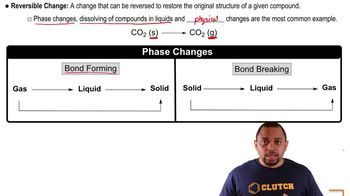At one time, a common means of forming small quantities of oxygen gas in the laboratory was to heat KClO3: 2 KClO3(s) → 2 KCl(s) + 3 O2(g) ΔH = -89.4 kJ For this reaction, calculate H for the formation of (a) 1.36 mol of O2
Consider the combustion of liquid methanol, CH3OH(l): CH3OH(l) + 3/2 O2(g) → CO2(g) + 2 H2O(l) ΔH = -726.5 kJ (a) What is the enthalpy change for the reverse reaction?

Verified Solution
Key Concepts
Enthalpy Change

Reverse Reaction

Thermodynamic Principles

At one time, a common means of forming small quantities of oxygen gas in the laboratory was to heat KClO3: 2 KClO3(s) → 2 KCl(s) + 3 O2(g) ΔH = -89.4 kJ For this reaction, calculate H for the formation of (b) 10.4 g of KCl.
At one time, a common means of forming small quantities of oxygen gas in the laboratory was to heat KClO3: 2 KClO3(s) → 2 KCl(s) + 3 O2(g) ΔH = -89.4 kJ (c) The decomposition of KClO3 proceeds spontaneously when it is heated. Do you think that the reverse reaction, the formation of KClO3 from KCl and O2, is likely to be feasible under ordinary conditions? Explain your answer.
Consider the combustion of liquid methanol, CH3OH(l): CH3OH(l) + 3/2 O2(g) → CO2(g) + 2 H2O(l) ΔH = -726.5 kJ (b) Balance the forward reaction with whole-number coefficients. What is ΔH for the reaction represented by this equation?
Consider the decomposition of liquid benzene, C6H6(l), to gaseous acetylene, C2H2(g): C6H6(l) → 3 C2H2(g) ΔH = +630 kJ (a) What is the enthalpy change for the reverse reaction?
Consider the decomposition of liquid benzene, C6H6(l), to gaseous acetylene, C2H2(g): C6H6(l) → 3 C2H2(g) ΔH = +630 kJ (b) What is H for the formation of 1 mol of acetylene?
